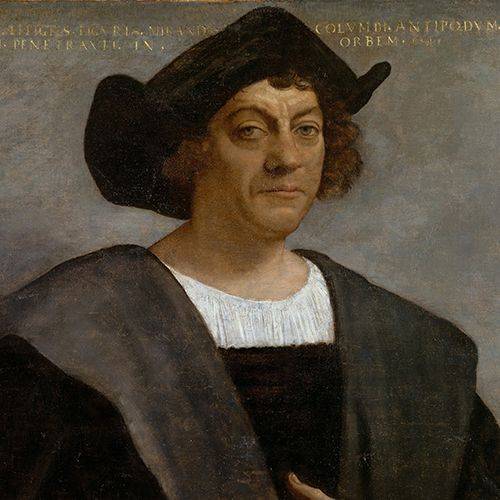President Trump has signed a proclamation declaring Monday to be Columbus Day, in an effort to “reclaim” what he called the famed explorer’s “extraordinary legacy of faith, courage, perseverance, and virtue.”
Christopher Columbus remains one of history’s most consequential and controversial figures. His transatlantic voyages connected two hemispheres that had developed in isolation for millennia, setting in motion transformations that would reshape the entire world. Yet the same expeditions that brought him fame also initiated devastating consequences for indigenous peoples of the Americas.
Born Cristoforo Colombo in 1451 in Genoa, Italy, Columbus grew up in a maritime republic where the sea offered opportunity and adventure. The son of a wool weaver, he went to sea at a young age, eventually settling in Portugal, where he married and studied navigation, cartography, and the accounts of previous explorers.
During the 1480s, Columbus became convinced that he could reach Asia by sailing westward across the Atlantic. This idea wasn’t novel—educated Europeans knew the Earth was round—but Columbus significantly underestimated the planet’s circumference. He believed Asia lay only 3,000 miles west of Europe, when the actual distance is closer to 12,000 miles. Unknown to him and other Europeans, two vast continents lay in between.

Columbus spent years seeking financial backing for his expedition. After Portugal’s King John II rejected his proposal, Columbus turned to Spain, where he found eventual success with Queen Isabella I and King Ferdinand II. The Spanish monarchs, fresh from completing the Reconquista by capturing Granada from Muslim rule, were willing to take a chance on the ambitious navigator.
In April 1492, the monarchs agreed to sponsor Columbus’s voyage. The contract promised Columbus the title of Admiral of the Ocean Sea, governance over any lands he discovered, and a percentage of any wealth generated. It was an extraordinarily generous agreement that reflected both Columbus’s persuasive abilities and Spain’s willingness to gamble on potential riches.
The Voyage of 1492
On August 3, 1492, Columbus departed from Palos de la Frontera with three ships: the Niña, the Pinta, and the Santa María. The crew of about 90 men faced an uncertain journey into waters unknown to Europeans. After stopping in the Canary Islands for supplies, they sailed westward into the open Atlantic.
The voyage tested the crew’s endurance. As weeks passed without sight of land, anxiety grew. Columbus kept two logs—one showing the true distance traveled, another showing a shorter distance to prevent panic. On October 12, 1492, after more than two months at sea, a lookout spotted land.
Columbus had reached an island in the Bahamas, which he named San Salvador. He believed he had reached islands near Asia, never realizing he had encountered a “New World” unknown to European civilization. Over the following weeks, he explored other Caribbean islands, including Cuba and Hispaniola, encountering the Taíno people and other indigenous groups.
Columbus made three more voyages to the Caribbean between 1493 and 1504. His second voyage in 1493 was a large colonization effort with 17 ships and over 1,000 men. He established the first permanent European settlement in the Americas at La Isabela on Hispaniola.
As governor of the new territories, Columbus proved far more skilled as a navigator than as an administrator. His governance was marked by harsh treatment of both Spanish colonists and indigenous peoples. He implemented systems forcing native populations to provide gold and labor, with brutal punishments for those who failed to meet quotas. Diseases brought by Europeans, for which indigenous peoples had no immunity, devastated populations throughout the Caribbean.
Columbus’s third voyage in 1498 brought him to the South American mainland for the first time. However, his governorship had become so troubled that Spanish authorities eventually arrested him in 1500 and sent him back to Spain in chains. Though he was pardoned and released, he never regained his governorship.
His final voyage in 1502-1504 explored Central America’s Caribbean coast, but Columbus spent months shipwrecked in Jamaica and returned to Spain in declining health. He died in Valladolid in 1506, still believing he had reached Asia, never fully grasping the magnitude of what he had found.
Columbus’s voyages initiated the Columbian Exchange, a massive transfer of plants, animals, culture, populations, technology, and ideas between the Eastern and Western hemispheres. Crops like potatoes, tomatoes, and maize traveled to Europe, while wheat, horses, and cattle came to the Americas. This biological exchange transformed diets, agriculture, and ecosystems worldwide.
However, the “exchange” came at a catastrophic human cost. The indigenous populations of the Caribbean were decimated within decades of Columbus’s arrival through a combination of disease, warfare, and forced labor. The Spanish colonization that followed Columbus’s voyages led to the destruction of complex civilizations, the suppression of indigenous cultures, and eventually the Atlantic slave trade that brought millions of Africans to the Americas in bondage.
Christopher Columbus stands at a pivotal moment in world history. His transatlantic voyages in the 1490s ended the isolation of the Americas and set in motion processes that created our interconnected modern world. The consequences of his expeditions—both the cultural exchanges and the tragic destruction of indigenous societies—continue to shape our world today.



This is in cape Charles not outside.
His skirt is showing!
History never states the actual truth of events . Trumps history will most likely be written in a way that…
There are reports that they are also talking about allowing RVs and Pickup trucks with Camper shells to be considered…
"Sadly, there’s a reason that REM song is so popular, you know the one, overplayed in every coming-of-age movie or…